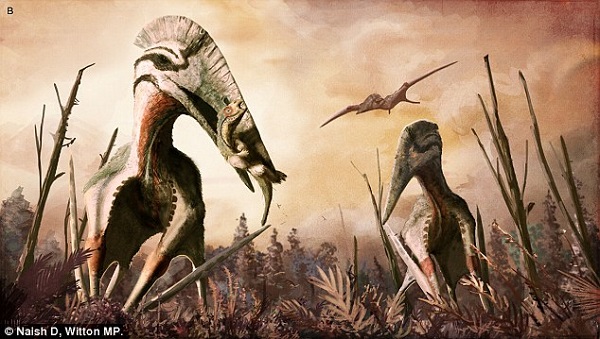Researchers have discovered a new fossil of a massive flying reptile that could eat its prey whole according to Daily mail.
The fossil was found in the Transylvania region of Romania and is believed to be 70 million years old.
The fossil is of Hatzegopteryx: A reptile with a short, massive neck and a jaw that’s about half a meter wide – large enough to swallow a small human or child.
Hatzegopteryx was a pterosaur – a flying reptile that existed at around the time of the dinosaurs.
At first, researchers thought that pterosaurs ate small baby dinosaurs the size of rats.
But these new fossils show that some large pterosaurs ate much bigger prey such as dinosaurs as large as a horse.
Pterosaurs grew very large during the late Cretaceous period – the last period of time when dinosaurs roamed the Earth.
It had a wingspan of 10 to 12-metres and may have eaten shellfish.
These huge flying birds belonged to a family called azdharchids who all had the same body structure – long legs, neck and wings.
But the research, found that Hatzegopteryx was an exception.
Its short, large neck made it much stronger than the other azdharchids discovered.
Its neck bone was broad with the walls measuring 4-6 millimetres thick, larger than other azhdarchids.
Its large, stocky body weighed almost a quarter of a tonne and would have been very dangerous – especially when taking into consideration its half a meter wide jaw.
Based on skulls recovered, experts think that the ancient reptiles had head crests (illustrated) which differed in size and shape between the sexes
The giant Hatzegopteryx lived on the island with other dinosaurs that were small.
The researchers said that because there weren’t many other large predators, Hatzegopteryx may have been one of the dominant predators.
Other surprising pterosaur fossil discoveries have been made over the years.
In 2014, palaeontologists found fully intact eggs laid by a pterosaur.
The fossils were discovered suggest that at least some of the animals lived in large nesting colonies, much like modern birds.
A total of five intact fossil eggs were found along with the bones of 40 adults.
They all belong to a previously unknown pterosaur species named Hamipterus tianshanensis, which had a wingspan of between 5ft (1.5 metres) and 11ft (3.4 metres).
Male and female skulls were recovered as well as vertebrae and limbs. Both sexes of the reptile had head crests, but the males’ were larger and a different shape than the females’.
N.H.Kh

